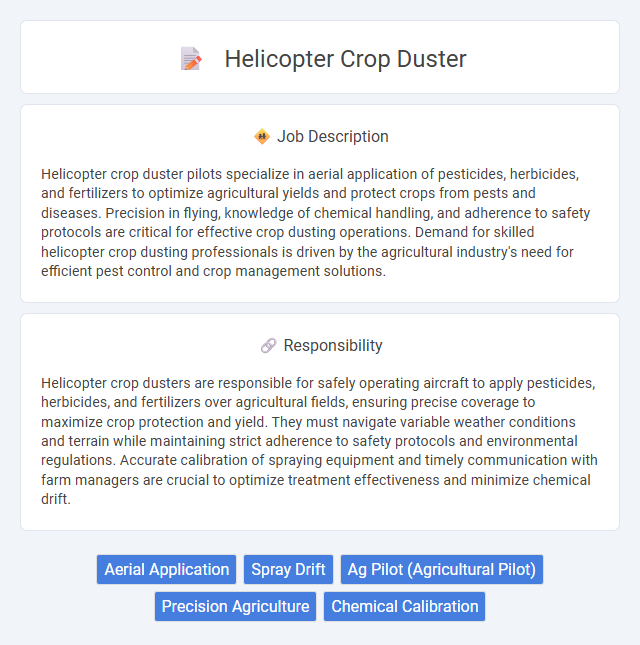
Helicopter crop duster pilots specialize in aerial application of pesticides, herbicides, and fertilizers to optimize agricultural yields and protect crops from pests and diseases. Precision in flying, knowledge of chemical handling, and adherence to safety protocols are critical for effective crop dusting operations. Demand for skilled helicopter crop dusting professionals is driven by the agricultural industry's need for efficient pest control and crop management solutions.
Helicopter crop duster pilots will likely need strong physical endurance and excellent spatial awareness due to the demanding nature of flying low and maneuvering over fields. Individuals who are comfortable with heights, have good reflexes, and can handle stressful situations might be more suitable for this job. Those prone to motion sickness or with a fear of flying may find this occupation challenging and less fitting to their capabilities.
Qualification
Helicopter crop duster pilots must possess a commercial pilot license with a rotorcraft rating and specialized training in agricultural aviation to ensure precise and safe pesticide application. Extensive knowledge of FAA regulations, aviation safety procedures, and chemical handling is essential, along with proficiency in GPS technology and aerial navigation. Physical fitness, quick decision-making skills, and experience in low-altitude flight operations are critical qualifications for effectively managing crop dusting missions.
Responsibility
Helicopter crop dusters are responsible for safely operating aircraft to apply pesticides, herbicides, and fertilizers over agricultural fields, ensuring precise coverage to maximize crop protection and yield. They must navigate variable weather conditions and terrain while maintaining strict adherence to safety protocols and environmental regulations. Accurate calibration of spraying equipment and timely communication with farm managers are crucial to optimize treatment effectiveness and minimize chemical drift.
Benefit
Helicopter crop dusting offers efficient and precise application of pesticides and fertilizers, potentially enhancing crop yields and reducing chemical waste. This method may allow operators to cover large agricultural areas quickly, minimizing labor costs and increasing productivity. Flying at low altitudes could enable targeted treatment, improving crop health while lessening environmental impact.
Challenge
Helicopter crop dusting presents significant challenges due to the need for precise navigation at low altitudes over uneven terrain, which increases the risk of accidents and requires exceptional piloting skills. Weather conditions such as wind and rain can unpredictably affect the dispersal of chemicals, complicating the effective treatment of crops. The demanding nature of this job often results in high physical and mental stress, making it suitable primarily for highly trained and experienced aviators.
Career Advancement
Helicopter crop duster pilots can advance their careers by gaining specialized certifications such as commercial pilot and agricultural aircraft operator licenses, enhancing their expertise in aerial application techniques. Experienced pilots often progress to supervisory or managerial roles within agricultural aviation companies, overseeing operations and ensuring compliance with safety regulations. Continuous training in new crop dusting technologies and precision agriculture methods also opens opportunities for career growth and higher earning potential.
Key Terms
Aerial Application
Helicopter crop dusters specialize in aerial application, efficiently delivering pesticides, herbicides, and fertilizers over large agricultural fields to protect crops and enhance yield. This method ensures precise coverage, reduces soil compaction compared to ground spraying, and allows for treatment in hard-to-reach or irregular terrain. Skilled pilots must navigate varying weather conditions and maintain strict safety protocols to optimize application effectiveness and minimize environmental impact.
Spray Drift
Helicopter crop duster pilots must expertly manage spray drift to minimize pesticide contamination and environmental impact. Understanding wind speed, direction, and droplet size is critical to ensure precise application and protect nearby water sources and non-target crops. Advanced technology, such as GPS-guided spray systems, enhances accuracy and reduces off-target chemical dispersion.
Ag Pilot (Agricultural Pilot)
Ag Pilots specializing as Helicopter Crop Dusters expertly maneuver helicopters to apply pesticides, herbicides, and fertilizers with precision over agricultural fields, maximizing crop yields while minimizing environmental impact. Their role demands advanced knowledge of aerial application techniques, aviation safety regulations, and weather conditions to optimize treatment effectiveness and reduce chemical drift. These pilots contribute significantly to sustainable farming practices by enhancing pest control efficiency and supporting large-scale crop production.
Precision Agriculture
Helicopter crop dusters play a vital role in precision agriculture by delivering targeted pesticide and fertilizer applications, enhancing crop yield and reducing chemical waste. Advanced GPS and real-time imaging technologies enable pilots to map fields accurately, ensuring precise distribution over variable terrain and crop conditions. This integration of aerial spraying techniques with data-driven farming optimizes resource use while minimizing environmental impact.
Chemical Calibration
Chemical calibration in helicopter crop duster operations ensures precise application rates of pesticides and fertilizers, optimizing crop protection and yield. Accurate calibration involves measuring nozzle output and adjusting spray pressure to match field requirements, minimizing chemical waste and environmental impact. Skilled pilots and technicians use specialized equipment to maintain consistent droplet size and distribution during aerial spraying.
 kuljobs.com
kuljobs.com